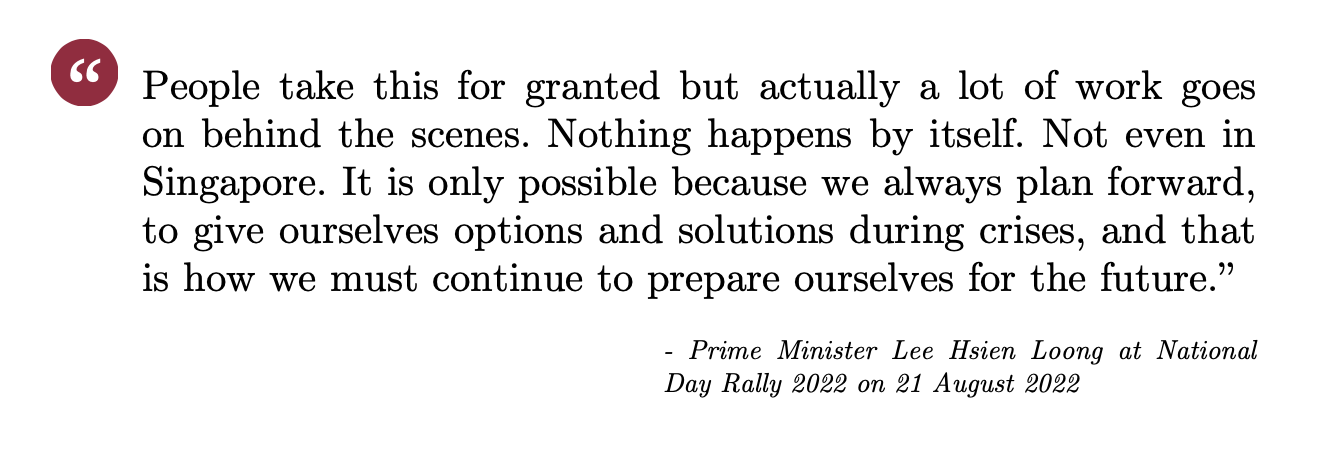Singapore's Food Challenge
Digging Deeper: Case Studies
Singapore’s Food Challenge
7 minute read
Over 90% of Singapore’s food comes from some 170 countries and regions. This reliance on food imports leaves us exposed to external forces – from supply shocks in source countries to disruptions in global supply chains. Climate change, which brings with it the loss of arable land and more erratic weather patterns, will put more strain on global food supply.
However, Singapore has built and strengthened our food resilience over the years.
One of the earliest efforts came about not long after the Japanese occupation, when local food production was primitive, hampered by disease and poor market conditions. In 1959, the Primary Production Department (PPD) was set up to provide for the socio-economic development of rural communities, including raising farming productivity. The measures took off, and by the 1980s, Singapore achieved self-sufficiency with the local production of eggs, poultry, and pork. Over time, however, with the scarcity of land, the number of farms dwindled out and we relied more on imports for our food needs.
But in the mid-2000s, the rising volatility in food prices – which eventually gave rise to the global food crisis in 2008 – prompted Singapore to rethink our strategy. Food imports and diversification had to be supplemented by secondary measures, such as stockpiling and local production.
Today, the Singapore Food Agency (SFA) strengthens Singapore’s food security by pursing three broad strategies called the “three Food Baskets”:
Basket 1: Diversify import sources
Singapore has been diversifying import sources to minimise the impact of supply disruptions. In 2021, we imported our food from a source network of over 170 countries, up from 140 countries in 2004.
Having a diversified network of food sources proved to be crucial in tiding us over challenges that came with the COVID-19 pandemic. As countries went into lockdowns or banned certain exports to cater to their domestic needs, SFA tapped its source network. In June 2020, Singapore received the first batch of eggs from Poland. Today, we also import oranges from Egypt, milk powder from Uruguay, and shrimps from Saudi Arabia, as part of efforts to broaden food supplies. This has allowed Singaporeans to enjoy steady access to food supplies despite disruptions from regular suppliers.
 (Image: Screenshot of Minister Chan Chun Sing’s Facebook post, 16 March 2020)
(Image: Screenshot of Minister Chan Chun Sing’s Facebook post, 16 March 2020)
Basket 2: Grow local
Complementing imports with local food production provides us with a buffer supply in the event of overseas supply disruptions, bolstering our food supply resilience.
In 2009, then-Agri-Food and Veterinary Authority of Singapore (AVA) launched the Food Fund, setting aside an initial sum of S$5 million to co-fund research and development in local food farming technology, upgrade local production capabilities, and diversify food sources. The plan was to increase Singapore’s self-sufficiency in eggs, fish, and leafy greens. In 2019, domestic farms met 26, 10 and 14 per cent of local needs for these items, respectively. The SFA is working towards its “30 by 30” vision – to build up our agri-food industry’s capability and capacity to produce 30 per cent of our nutritional needs locally and sustainably by 2030.
Technology is a key enabler in helping farms do more with less – we invest in agri-tech to make local farms more efficient and productive. For instance, Aquaculture Technologies, Singapore’s first smart floating fish farm. Located off the coast of Pasir Ris, the facility runs on artificial intelligence and video analytics. It expects to produce ten times the minimum yield of a typical coastal fish farm at full capacity.
Beyond producing food at scale, technology can also be harnessed to develop new, alternative, and sustainable food sources. The Agency for Science, Technology and Research’s new food and biotechnology institution is working to boost Singapore’s local produce capabilities by developing new, alternative, and sustainable food sources – like crabmeat that come from labs.
Basket 3: Grow overseas
With help from SFA, local companies have exported their urban food solutions overseas and stepped into bigger markets while contributing to food supply at home by exporting food back. For example, Barramundi Asia, which rears barramundi in seawaters near Singapore, has expanded into Australia and Brunei, while vertical farm Sky Greens has ventured into Thailand and China. Local hydroponics farm Sustenir Agriculture has also forayed into Hong Kong.

(Video: “Singapore has built food resilience with buffer stocks, diversified sources: PM Lee” by CNA)

